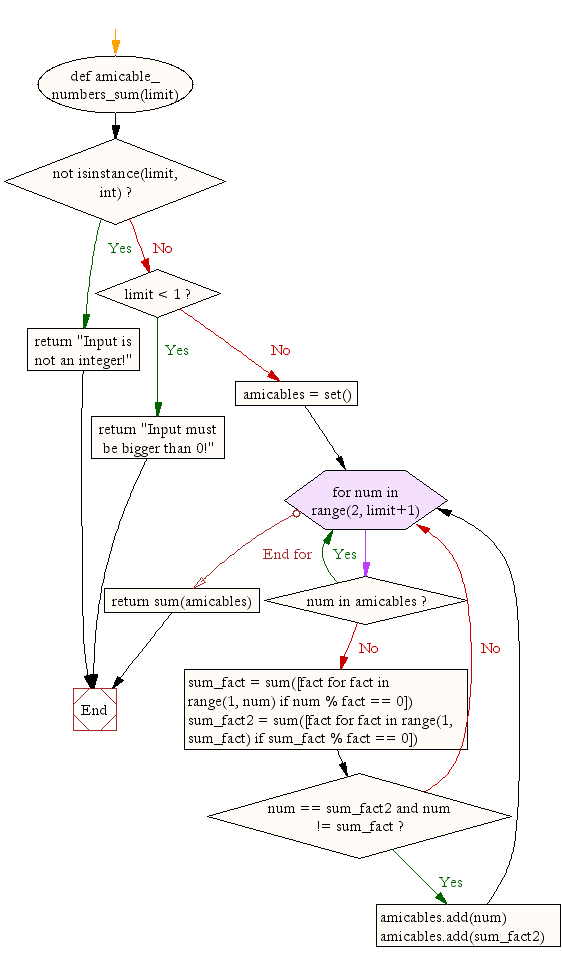Python Math: Sum all amicable numbers from 1 to specified numbers
Python Math: Exercise-14 with Solution
Write a Python program to sum all amicable numbers from 1 to specified numbers.
Note: Amicable numbers are two different numbers so related that the sum of the proper divisors of each is equal to the other number. (A proper divisor of a number is a positive factor of that number other than the number itself. For example, the proper divisors of 6 are 1, 2, and 3.)
Sample Solution :-
Python Code :
def amicable_numbers_sum(limit):
if not isinstance(limit, int):
return "Input is not an integer!"
if limit < 1:
return "Input must be bigger than 0!"
amicables = set()
for num in range(2, limit+1):
if num in amicables:
continue
sum_fact = sum([fact for fact in range(1, num) if num % fact == 0])
sum_fact2 = sum([fact for fact in range(1, sum_fact) if sum_fact % fact == 0])
if num == sum_fact2 and num != sum_fact:
amicables.add(num)
amicables.add(sum_fact2)
return sum(amicables)
print(amicable_numbers_sum(9999))
print(amicable_numbers_sum(999))
print(amicable_numbers_sum(99))
Sample Output:
31626 504 0
Pictorial Presentation:
Flowchart:

Visualize Python code execution:
The following tool visualize what the computer is doing step-by-step as it executes the said program:
Python Code Editor:
Have another way to solve this solution? Contribute your code (and comments) through Disqus.
Previous: Write a Python program to find out, if the given number is abundant.
Next: Write a Python program to returns sum of all divisors of a number.
What is the difficulty level of this exercise?
Test your Programming skills with w3resource's quiz.
Python: Tips of the Day
Find current directory and file's directory:
To get the full path to the directory a Python file is contained in, write this in that file:
import os dir_path = os.path.dirname(os.path.realpath(__file__))
(Note that the incantation above won't work if you've already used os.chdir() to change your current working directory, since the value of the __file__ constant is relative to the current working directory and is not changed by an os.chdir() call.)
To get the current working directory use
import os cwd = os.getcwd()
Documentation references for the modules, constants and functions used above:
- The os and os.path modules.
- The __file__ constant
- os.path.realpath(path) (returns "the canonical path of the specified filename, eliminating any symbolic links encountered in the path")
- os.path.dirname(path) (returns "the directory name of pathname path")
- os.getcwd() (returns "a string representing the current working directory")
- os.chdir(path) ("change the current working directory to path")
Ref: https://bit.ly/3fy0R6m
- New Content published on w3resource:
- HTML-CSS Practical: Exercises, Practice, Solution
- Java Regular Expression: Exercises, Practice, Solution
- Scala Programming Exercises, Practice, Solution
- Python Itertools exercises
- Python Numpy exercises
- Python GeoPy Package exercises
- Python Pandas exercises
- Python nltk exercises
- Python BeautifulSoup exercises
- Form Template
- Composer - PHP Package Manager
- PHPUnit - PHP Testing
- Laravel - PHP Framework
- Angular - JavaScript Framework
- Vue - JavaScript Framework
- Jest - JavaScript Testing Framework
